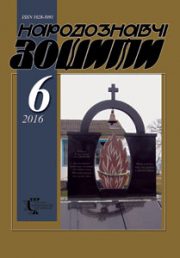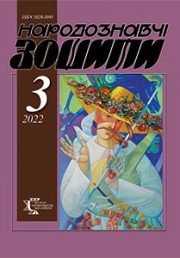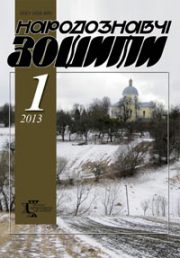The Ethnology Notebooks. 2018, 2 (140), 494—501.
UDK 75.052/058(477.83-22)-0552
DOI https://doi.org/10.15407/nz2018.02.494
Received 13.03.2018
TRADITIONAL PAINTING OF YAVORIV DISTRICT AS A SOURCE OF ARTISTIC INSPIRATIONS OF NATALIIA DIUG
ORCID ID: https://orcid.org/0000-0002-9719-4432
Shpak Oksana, Candidate of Sciences in Art Studies,
Senior Researcher
at Folk Art Department
of the Institute of Ethnology
of the National Academy of Sciences of Ukraine.
Svobody Avenue 15, 79000, Lviv, Ukraine.
Contacts: e-mail: shpak.oksana@gmail.com
Abstrakt. Local tradition of wood painting of Yavoriv district, dйcor of painted coffers of the 19th — first half of the 20 century, painting of children’s toys of the late 19th — 20th centuries form the basis of creative work of the artist Nataliia Diug, who resides and works in the township of Ivano-Frankove, Yavoriv district, Lviv region. The artist works in the field of easel painting, creating her pictures with acrylic paints on glass and textile. There are two directions in Nataliya Diug’s creative work: connection with tradition of Yavoriv folk painting and innovation in technique and material, typology and stylistics of her works.
Keywords: folk decorative art of Yavoriv district, decorative painting, painted coffers, Yavoriv folk toys, motives of ornament, interpretation, ethno-art tradition
REFERENCES
Herus, L. (2004). Ukrains’ka narodna ihrashka. L’viv: NAN Ukrainy; Instytut narodoznavstva [in Ukrainian].
Herus, L. (1995). Yavorivs’ka narodna ihrashka: istoriia rozvytku ta suchasni prooblemy promyslu. Zapysky Naukovoho tovarystva imeni Shevchenka. (Vol. SSXXX. Pratsi sektsii etnohrafii ta fol’klorystyky, pp. 176—189). L’viv: Naukove tovarystvo imeni Shevchenka [in Ukrainian].
Najden, O.S. (1989). Ornament ukrains’koho narodnoho rozpysu: Vytoky, tradytsii, evoliutsiia. Kyiv: Naukova dumka [in Ukrainian].
Kavas, K.M. (avt. tekstu ta uporiadnyk). (2011). Nataliia Volodymyrivna Diuh: Khudozhnytsia, pedahoh i vykhovatel’, majster. KhPTU, 14, 52. Ivano-Frankove [in Ukrainian].
Stankevych, M.Ye. (2004). Avtentychnist’ mystetstva. Pytannia teorii plastychnykh mystetstv. Vybrani pratsi. L’viv: SKIM [in Ukrainian].
Stankevych, M.Ye. (2002). Ukrains’ke khudozhnie derevo XVI—XX st. L’viv: NAN Ukrainy; Instytut narodoznavstva [in Ukrainian].
Chuhaj, R.V. (1979). Narodne dekoratyvne mystetstvo Yavorivschyny. Kyiv: Naukova dumka [in Ukrainian].






